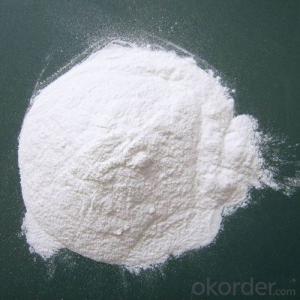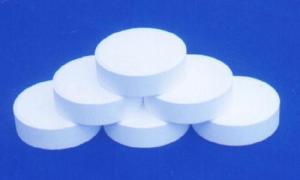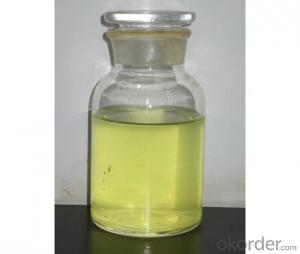Hydroxypropyl Methyl Cellulose for Industrial Construction
- Loading Port:
- Tianjin
- Payment Terms:
- TT OR LC
- Min Order Qty:
- 5000 kg
- Supply Capability:
- 5000000 kg/month
OKorder Service Pledge
OKorder Financial Service
You Might Also Like
Building Construction Hydroxypropyl Methyl Cellulose (HPMC)
Brief introduction:
Hydroxypropyl Methyl Cellulose (HPMC) helps building materials apply more easily and perform better. They provide water retention and cohesiveness to mixtures. With special modification, it can be used to control thickening, water demand, workability, sag resistance, strength and other important properties of the final product.
It is widely used as thickener, adhesive, water preserving agent, film-foaming agent in building materials, industrial coatings, synthetic resin, ceramic industry, medicine, food, textile, agricultural, cosmetic and other industries.
Physical and chemical index:
Item | Specification |
CAS NO. | 9004-65-3 |
Appearance | white or light yellow powder |
Moisture Content | ≤5.0% |
PH | 4.0-8.0 |
Particle Size | min. 98% pass through 100 mesh |
Viscosity | 100cps-200000cps, 2% solution |
Application in Building:
External wall insulation system (EIFS)
>Bond strength: HPMC can provide the greatest degree of high adhesive bond strength of mortar.
>Performance: The mortar added HPMC has the right consistency, non-sagging. When using, the mortar is easy to work continuously, uninterrupted.
>Water retention: HPMC can wet the wall insulation easily, easy to paste, and also make other additional materials reach the best affects.
>Absorbent: HPMC can minimize the air-entraining volume, lower water absorption of mortar.
>Recommended brand: 75CMAX75000(S), 75CMAX100000(S), 75CMAX200000(S)
Interior and exterior wall interface agent
>Easy to mix, without of agglomeration: HPMC can significantly reduce the friction in the dry powder during the process of mixing with water, which makes it easy to mix and save the blending time.
>Water retention: HPMC can significantly reduce the moisture absorption by the wall. Good water retention can ensure the cement compound with a longer time, also can ensure that workers are able to carry out many times of scraping for the putty on the wall.
>Good working performance stability: even in high temperature environment, HPMC can still maintain good water retention. it is suitable for construction in the summer or hot areas.
>Increased water demand: HPMC can significantly improve the water demand of the putty materials. On the one hand, it improves the operational time after putty put on the wall, on the other hand, it can increase the coating are of the putty, which can make the formula more economical.
>Recommended brand: 75CMAX60000(S), 75CMAX75000(S)
Tile adhesive
>Water retention: HPMC can reduce the moisture absorbed by the substrate and the tile, retain the moisture in the adhesives as much as possible, making mortar still have adhesion after coating for a long time. Significantly extend open time and makes bigger coating area for the worker each time, and improve the efficiency.
>Improve bond strength, improve anti-slip performance: HPMC ensure non sagging of the tiles during working, especially for heavy tile, marble and other stone materials.
>Work performance: The lubricity of HPMC can increase the workability of the mortar significantly, which makes the mortar easy to coating and improve efficiency.
>Improve mortar wetting property: HPMC give mortar consistency, enhance the wetting ability of mortar and substrate, increase the binding strength of wet mortar, especially for the recipe with high water cement ration;
>Recommended brand: 75CMAX40000(S), 75CMAX75000(S), 75CMAX100000(S)
Crack Filler
>Workability: provide the right viscosity, plasticity, and easy to work;
>Water retention: can make the slurry fully hydrated, extending the working time and avoid cracking.
>Anti-hanging: HPMC can make a strong adhesion on the surface for the slurry and not sag;
>Recommended brand: 75CMAX40000(S), 75CMAX75000(S), 75CMAX100000(S)
Self-leveling mortar
>Prevent bleeding: HPMC can play a very good role to prevent the slurry sedimentation, bleeding.
>Maintain liquidity, and improve retention: low viscosity HPMC will not affect the slurry flow effect and easy to work. While possesses certain water retention, makes the good surface effect after self-levelling and avoid cracks.
>Recommended brand: 75CMAX400~600
Gypsum-based plaster
>Water retention: HPMC can retain moisture in the mortar, thus make gypsum completely solid. The higher the viscosity is, the stronger the water-retention capacity, vice versa..
>Sag resistance: allow the worker make the thick coating without causing ripple building.
>Mortar yield: For fixed weight of dry mortar, the exist of HPMC can provide more wet mortar.
>Recommended brand: 75CMAX75000(S), 75CMAX100000(S)


FAQ
Q1.Could we have the sample to test the quality?
Kindly send us your address, we are honored to offer you samples.
Q2. How does your company do regarding quality control?
CNBM a Chinese state-owned enterprise ranked 270th among the global fortune 500 in 2015,
have accreditation in line with standard:ISO 9001:2000,SGS,CIQ certificate.
Q3:What's your Delivery Time?
In generally, the delivery time is 25 days-30 days.We will make the delivery as soon as possible with the guaranted quality.
Q4:What is the convenient way to pay?
L/C , T/T ,Paypal, Western Union and Escrow are accepted,and if you have a better idea , please feel free to share with us .
Q5:Which mode of transport would be better?
In general,we advice to make delivery by sea which is cheap and safe.Also we respect your views of other transportation as well.
- Q: what is the role of a catalyst in a chemical reaction?
- A catalyst speeds up a chemical reaction by providing an alternate reaction pathway with a lower activation energy. Since the activation energy is lower, more product will be formed in the same amount of time. Chemists used to assume that a catalyst somehow sped up a reaction without being consumed in the reaction. We now know that a catalyst will be a reactant in one step of a reaction mechanism, and will be a product in a subsequent step in the mechanism, so that it **appears** that the catalyst does not take part in the reaction. ======== Follow up ========= Remember, it is customary to cite one's sources when quoting from another source or when simply copying large passages from Wikipedia or some other web page.
- Q: How do I write about the ion equation?
- 4NH3 + 5O2 == 4NO + 6H2O
- Q: Seems intuitive that it wouldn't, but I dunno the qualitative difference between activation energy & Gibbs free energy. I'M TOO LAZY TO GOOGLE I GOTS STUFF TO DO
- A catalyst can change the activation energy not the Gibbs energy. The Gibbs energy is the energy difference between the initial state and final state. A catalyst cannot change that. Imagine you are driving from school to home. How you drive do not change the height difference between the school and your home. However, a catalyst can change your path which can change the routine you drive from school to home. So if there is a hill in between your school and you home, you have the choice to drive through it or drive around. Here is a picture: upload.wikimedia.org/wikipedia/co... A catalyst can change the height of the barrier, but cannot alter the initial or final state.
- Q: Explain how a catalyst may increase the rate of chemical reaction?
- A catalyst lowers the activation energy of a reaction without affecting the reaction in any way.
- Q: okay im doing a project for my classroom about catalyst and i have to draw a picture but when i looked up on google i just saw a bunch of random stuff and a couple were metal so thats why im asking this question. :)
- A catalyst is something that enables a process to take place without being part of said process itself, such as in a chemical reaction.
- Q: What is the standard for the storage of flammable and explosive chemicals now?
- First, the basic requirements of classification of storage Dangerous goods, variety, complex performance, storage, in accordance with the zoning, classification, sub-section of the principle of special storage, set the number, set the number of fixed warehouses, fixed staff (four) custody. Small warehouses should be classified, divided, sub-stack storage, the performance of each other, fire fighting different items, dangerous dangerous goods and other general dangerous goods, should be stored separately.
- Q: Chemical master invited (about catalyst)
- From the thermodynamics can be reaction, and the three formulas can be added to eliminate the intermediate product, indicating that the reaction may occur. The definition of the catalyst is not complete. I am a junior undergraduate student of Jilin University School of Chemistry, according to the definition of the catalyst in the university textbook, the catalyst itself reacts with the reactants to produce unstable intermediates. After the reaction is finished, the intermediate product is explained and the catalyst is reduced. Apparently did not participate in the reaction. So the catalyst to change the course of the reaction, the original reactants to go through a relatively high energy to produce products, there will be a catalyst after a few relatively low energy barrier, so much easier, the reaction rate is greatly accelerated The It can be seen, the catalyst is not no response, but only after the completion of the reaction to restore it. It can also be seen that the amount of catalyst does not matter, and some reactions require the amount of catalyst to be approximately equal to the amount of reactants. Waiting for you to high school and university to further study on this issue will have a more clear understanding of the.
- Q: Several experiments were carried out using catalysts
- Hydrogen peroxide in the manganese dioxide as a catalyst for decomposition reaction: 2H2O2 == MnO2 == 2H2O + O2 ↑ (laboratory oxygen principle)
- Q: I have just spent CAN$550 to replace a catalyst converter at one end of the muffler. The repairman said I need to replace the oxygen sensor very soon, otherwise, the C.C. will be gone again. Is that true... can someone confirm this for me. Thanks.
- The oxygen sensor is a sensor that reads between 1-5v. The computer uses the feedback response from the oxygen sensor, to let it know how much fuel should be introduced into the engine,and then compares the oxygen sensors voltage to a predetermined set prgram in the computer. If the signal from the oxygen sensor is out of the range of the computers program. The computer kicks on the service engine soon lite. Too much gas will cause the cat to overheat and ruin it. Change the sensor as soon as possible.
- Q: role of catalyst?
- Catalysts are used to increase the rate of chemical reactions.
Send your message to us
Hydroxypropyl Methyl Cellulose for Industrial Construction
- Loading Port:
- Tianjin
- Payment Terms:
- TT OR LC
- Min Order Qty:
- 5000 kg
- Supply Capability:
- 5000000 kg/month
OKorder Service Pledge
OKorder Financial Service
Similar products
Hot products
Hot Searches
Related keywords

























